Abstract
Among the various possible ways of dealing with notch and crack situations, the scaled boundary finite element method [SBFEM, (Wolf and Song in Finite element modelling of unbounded structures. Wiley, Chichester, 1996; Wolf in The scaled boundary finite element method. Wiley, Chichester, 2003)] has been adopted in this work. This method has been proved to be versatile, much less time consuming than the finite element method and generates highly accurate numerical predictions in cases of structures with notches and cracks. The SBFEM gives the advantage of boundary element method by reducing one dimension in modelling the structures but the mathematical formulations are more related to conventional displacement based finite element method. This method requires a certain scalability of the given structure with respect to a point called similarity center. Like in the case of the boundary element method, the structure needs to be discretized only at the surface where standard displacement based isoparametric finite element formulations are adequate. Unlike in the boundary element method, however, no fundamental solution is required by the scaled boundary finite element method. The similarity or scalability of the method requires separation of coordinates such that in the radial direction (i.e. scaling direction) it yields simple differential equations that can be solved analytically. So this approach can be considered as a semi-analytical method. Several two-dimensional examples have been analysed for crack and notch situations that are well known cases in fracture mechanics. A number of three-dimensional cases have been considered for different crack configurations that yield high order of singularity. The results, according to the authors’ knowledge are up to now unpublished in the open literature. Parametric studies are conducted for structures with bi-material interfaces.
Similar content being viewed by others
References
Barsoum RS (1988) Theoretical basis of the finite element iterative method for the eigenvalue problem in stationary cracks. Int J Numer Methods Eng 26: 531–539
Barsoum RS (1990) Asymtotic fields at interfaces using the finite element iterative method. Comput Struct 35: 285–292
Barsoum RS, Chen TK (1991) Three-dimensional surface singularity of an interface crack. Int J Fract 50: 221–237
Bazant ZP, Keer LM (1974) Singularities of elastic stresses and of harmonic functions at conical notches or inclusions. Int J Solids Struct 10: 957–964
Bird GE, Trevelyan J, Augarde CE (2010) A coupled BEM/ scaled boundary FEM formulation for accurate computations in linear elastic fracture mechanics. Eng Anal Boundary Elem 34: 599–610
Chidgzey S, Deeks AJ (2005) Determination of the coefficients of crack tip asymptotic fields using the scaled boundary finite element method. Eng Fract Mech 72: 2019–2036
Chidgzey SR, Trevelyan J, Deeks AJ (2008) Coupling of the boundary element method and the scaled boundary finite element method for computations in fracture mechanics. Comput Struct 86: 1198–1203
Deeks AJ (2002) Calculation of stress-intensity factors using the scaled boundary finite-element method. In: Proceedings of the international conference on structural integrity and fracture, Perth, pp 3–8
Deeks AJ, Wolf JP (2002) A virtual work derivation of the scaled boundary finite-element method for elastostatics. Comput Mech 28: 489–504
Delale F (1984) Stress singularities in bonded anisotropic materials. Int J Solids Struct 20: 31–40
Dimitrov A, Andrä H, Schnack E (2001) Efficient computation of order and mode of corner singularities in 3D-elasticity. Int J Numer Methods Eng 52: 805–827
Ding S, Kumosa M (1994) Singular stress behaviour at an adhesive interface corner. Eng Fract Mech 47: 503–519
Gu L, Belytschko T (1994) A numerical study of stress singularities in a two-material wedge. Int J Solids Struct 31: 865–889
Leguillon D, Sanchez-Palencia E (1987) Computation of singular solutions in elliptic problems and elasticity. Masson, Wiley, Paris
Lehmann L (2007) Wave propagation in infinite domains. Lecture Notes in applied and computational mechanics, Vol 31. Springer
Mittelstedt C, Becker W (2005) Semi-analytical computation of 3D stress singularities in linear elasticity. Commun Numer Methods Eng 21: 247–257
Müller A, Wenck J, Goswami S, Lindemann J, Hohe J, Becker W (2004) The boundary finite element method for predicting directions of cracks emerging from notches at bimaterial junctions. Eng Fract Mech 72: 373–386
Sator C (2010) Asymptotische Nahfeldanalysen ebener Multi-Materialverbindungsstellen mit der Methode komplexer Potentiale. Ph.D. Dissertation, Dept. of Mechanical Engineering, Technical University of Darmstadt, Germany
Somaratna N, Ting TCT (1986) Three-dimensional stress singularities in anisotropic materials and composites. Int J Eng Sci 24: 1115–1134
Song C, Wolf JP (1997) The scaled boundary finite-element method—alias consistent infinitesimal finite-element cell method—for elastodynamics. Comput Methods Appl Mech Eng 147: 329–355
Song C, Wolf JP (1999) Body loads in scaled boundary finite element method. Comput Methods Appl Mech Eng 180: 117–135
Song C, Wolf JP (2000) The scaled boundary finite element method—a primer: solution procedures. Comput Struct 78: 211–225
Wolf JP (2003) The scaled boundary finite element method. Wiley, Chichester
Wolf JP, Song C (1996) Finite element modelling of unbounded structures. Wiley, Chichester
Yang ZJ, Deeks AJ (2007) Modelling cohesive crack growth using a two-step finite element-scaled boundary finite element coupled method. Int J Fract 143: 333–354
Author information
Authors and Affiliations
Corresponding author
Rights and permissions
About this article
Cite this article
Goswami, S., Becker, W. Computation of 3-D stress singularities for multiple cracks and crack intersections by the scaled boundary finite element method. Int J Fract 175, 13–25 (2012). https://doi.org/10.1007/s10704-012-9694-2
Received:
Accepted:
Published:
Issue Date:
DOI: https://doi.org/10.1007/s10704-012-9694-2




